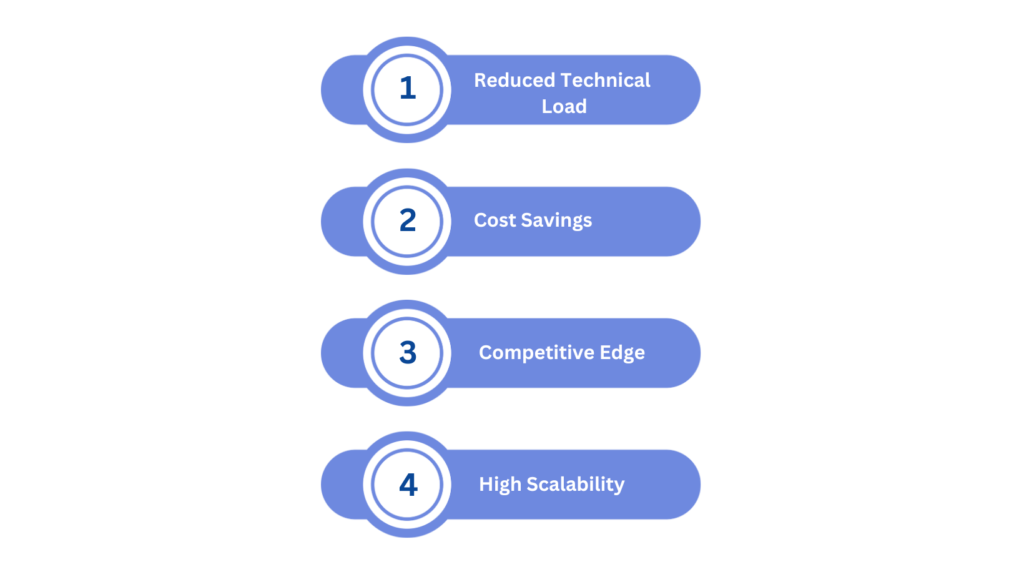The telemedicine sector is experiencing unprecedented growth, surpassing pre-pandemic levels, as healthcare providers increasingly embrace white-label telemedicine apps for swift and effective entry into virtual care. These customizable platforms, adorned with a provider’s branding and specific features, enable video consultations, text communications, and electronic prescriptions. The surge in telemedicine adoption underscores a significant shift in patient expectations and the overall healthcare landscape.
Developing a white-label telemedicine app is a flexible and responsive approach to address the pressing demand for convenient and effective virtual healthcare services. In this blog, we will delve into the essential steps, crucial features, and the investment needed to build a white-label telemedicine app that captivates patients and distinguishes itself in the digital healthcare market.
What is a White-Label Telemedicine App?
A white-label telemedicine app is a personalized digital healthcare solution that allows healthcare providers to label it as their own. It offers a fast and effective entry into the virtual care realm without extensive development. This ready-to-use application facilitates remote interactions between patients and doctors, incorporating features like video consultations, secure messaging, and prescription management.
For healthcare providers aiming to carve out a unique brand presence, the customization capabilities of a white-label telemedicine app are indispensable. Integrating logos, color schemes, and other branding elements allows healthcare organizations not only to strengthen their identity but also to cultivate trust with patients. This tailored approach ensures a unified experience that resonates with the established image of the organization.
According to Grand View Research, the telemedicine market is expected to be worth $455.26 billion by 2030, growing at a rate of 24.0% annually from 2023 to 2030. This significant growth is driven by better internet access and improvements in smartphone technology, which help bridge gaps in service delivery.
How Are White-Label Telemedicine Apps Different from Custom-Built Solutions?
Custom-Built SolutionsTailor-made telemedicine solutions are developed from the ground up to address specific requirements, providing unparalleled flexibility but demanding significant time and resources. On the other hand, white-label apps offer a more efficient approach, enabling organizations to swiftly enter the virtual care market with reduced development complexity. The crucial distinction lies in the extent of customization and the level of involvement in the development process.?
Take, for example, a telehealth startup deciding on a custom-built solution to integrate distinct features designed for a specific healthcare niche. On the other hand, a clinic seeking rapid entry into telemedicine might opt for a white-label app, enjoying the advantages of a quicker launch and lower development costs.
Why Should You Invest in Building a White-Label Telemedicine Platform?
In the swiftly evolving healthcare industry, keeping abreast of technological trends is crucial.
Here are some compelling reasons to contemplate an investment in a white-label telemedicine platform:

Reduced Technical Load
Choosing a white-label solution effectively minimizes technical challenges, eradicating the necessity for extensive tech expertise within your team. Healthcare providers can reap the advantages of white-labeling a telemedicine app by entrusting the intricate development tasks to a specialized firm. This allows you to shift your focus from development to strategic deployment and user acquisition. Such an approach streamlines app updates and maintenance, ensuring seamless operation. You can provide high-quality healthcare services with a dependable, professionally developed app, keeping your platform current with less effort and investment.
Cost Savings
It’s common for individuals to dwell extensively on the development cost of a custom white-label telemedicine app. However, it’s essential to recognize that investing in such solutions can lead to significant cost savings for healthcare practices. The upfront development cost is balanced by long-term savings achieved through the reduction of physical space requirements and the streamlining of administrative processes.
Competitive Edge
Choosing white-label telemedicine platform development sets your app apart in a saturated market. Providing a strong telemedicine service positions your business at the forefront of modern healthcare. This showcases a dedication to innovation, enhancing patient retention, and attracting tech-savvy consumers.
High Scalability
The advantage of tailor-made telemedicine apps lies in their scalability. As your healthcare practice expands, these platforms adjust to rising demand without requiring significant investments in physical infrastructure. They offer the flexibility to scale up or down based on patient flow, market trends, and the evolving business needs of healthcare providers.
Key Features and Functionality of White-Label Telemedicine Platforms
Appointment Scheduling:
A white-label telemedicine app development incorporates a user-friendly appointment scheduling feature for added convenience. It should empower patients to effortlessly book, reschedule, or cancel appointments, thereby enhancing time management for both patients and providers. The system should be intuitive, facilitating a swift overview of available slots and seamless confirmation of appointments without any hassle.
Video/Voice Calling
Top-notch video and voice calling constitute a fundamental feature in the development of white-label telemedicine apps. It enables patients to engage in real-time consultations with healthcare providers, elevating the overall care delivery experience. This functionality should be robust and user-friendly, guaranteeing dependable communication across different devices and networks.
Calendar Integration
Efficient calendar integration facilitates synchronization with personal calendars, sending timely reminders for upcoming appointments. It is essential for maintaining organization and punctuality for both patients and healthcare providers. This feature should accommodate multiple calendar formats and offer real-time updates to avoid any scheduling conflicts.
Notifications and Reminders
In white-label telemedicine app development, timely notifications, and reminders play a crucial role in significantly improving patient compliance. Functioning as a personal assistant for health management, these features alert patients to take medications, attend appointments, or follow up on treatment plans. This proactive engagement aids in maintaining treatment continuity and enhances overall health outcomes.
Automated Clinical Notes
Integrating automated clinical notes represents a breakthrough in telemedicine, simplifying the documentation process for healthcare providers. This feature guarantees the accurate and efficient capture of every patient interaction, essential for quality control and legal compliance. Additionally, it promotes improved coordination of care among medical staff.
Electronic Health Records
Foundational to contemporary healthcare, Electronic Health Records (EHRs) create a thorough digital representation of a patient’s medical history. They empower physicians to monitor changes in health over time, verify medication accuracy, and effortlessly share vital information with patients and other healthcare professionals.
Cloud Storage
Dependable cloud storage solutions within telemedicine platforms bring unmatched advantages, including real-time data synchronization and remote accessibility to patient information. This technology guarantees the security of patient data against unauthorized access while also ensuring its immediate availability for medical consultations—essential in today’s mobile-centric environment.
Multilingual Support
Multilingual support stands as a crucial feature, ensuring that white-label telemedicine software is inclusive for a diverse patient demographic. It enables patients from different linguistic backgrounds to confidently access services, fostering enhanced patient engagement, satisfaction, and potentially, better health outcomes. This support plays a significant role in extending the reach and impact of health services.
Administrative Dashboard
A well-designed administrative dashboard is a pivotal element for handling the intricacies of telehealth services. It equips practitioners and healthcare administrators with robust tools for scheduling, reporting, and operational oversight. In a white-label telemedicine platform, such a dashboard streamlines processes lessens administrative burdens, and improves the delivery of care. This is achieved by providing a comprehensive view of patient engagements and healthcare services management.
Security and Compliance
Security and compliance serve as fundamental pillars in the creation of a telemedicine application. It is imperative to integrate advanced security protocols and adhere to healthcare
regulations like HIPAA during the development of white-label telemedicine apps. These measures are non-negotiable, protecting patient data from breaches and unauthorized access. This commitment upholds the integrity of telehealth services, strengthening patient confidence in the digital healthcare.
AR for Anatomy Visualization
In telemedicine platforms, the integration of Augmented Reality (AR) for anatomy visualization introduces a dynamic dimension, enabling patients and physicians to engage with 3D models of human anatomy. This technology has the potential to revolutionize patient education by offering vivid, interactive depictions of intricate medical conditions and procedures. It elevates the comprehension of diagnoses and treatments, fostering more engaging and informative discussions between doctors and patients.
AI-Powered Symptom Checker
An AI-powered symptom checker is an innovative tool that enhances the value of patient interactions. Analyzing symptoms and offering potential diagnoses, it aids patients in comprehending their health conditions before seeking advice from a healthcare professional. This feature not only streamlines the care pathway but also maximizes the efficiency of clinical staff, ensuring that the initial patient contact is well-informed.
Wearable Integration
Integrating wearables into telemedicine platforms facilitates the real-time monitoring of essential health metrics, offering a continuous stream of data for preventive care and the management of chronic diseases. This empowers patients to effortlessly communicate updates on their heart rate, sleep patterns, and activity levels to their healthcare providers. The seamless exchange of this information supports proactive health management, enabling the creation of personalized care plans based on the data derived from patients’ daily lives.
By incorporating these advanced features, your telemedicine platform can ascend to a leading position in the healthcare industry. This integration not only ensures a comprehensive service but also positions your platform to seamlessly adapt to future healthcare innovations, further solidifying its relevance and effectiveness in the evolving landscape of telemedicine.
White-Label Telemedicine App Development Process
Understanding the essential steps for launching a comprehensive telemedicine solution is crucial to ensure a successful initiation of the creation process.
Market Research and Strategy Formulation
The foundation for successful white-label telemedicine app development lies in extensive market research and strategic planning. Delve deeply into understanding the healthcare needs of target users, conducting a thorough analysis of competing solutions, emerging trends, and strict telehealth regulations. Develop a distinct and clear value proposition that sets your app apart in the market. Thoughtfully identify the necessary features and functionality to meet user expectations and adhere to healthcare standards.
Develop a strategic approach to the revenue model by carefully considering options such as subscription services, freemium access, or per-transaction fees. Create a realistic budget and timeline that takes into consideration the complexities of both development and deployment. Define tangible milestones and key performance indicators to track progress and ensure that the development journey stays on course for success.
Compliance and Security Protocols Establishment
It is essential for white-label telemedicine software to establish transparent authorization levels and access policies, ensuring that security measures are not only implemented but also rigorously adhered to. Conducting regular risk assessments and penetration testing is crucial for identifying and addressing potential vulnerabilities. Furthermore, obtaining the required clearances and licenses for telehealth operations is a pivotal step in the overall process.
Customization and Branding Implementation
Customization is crucial when adapting a solution to meet specific operational needs. This entails tailoring the user interface to mirror the visual identity of the brand, including modifications to color schemes, logos, and user experience elements to establish a cohesive brand experience. As this process unfolds, the white-label telemedicine platform evolves beyond a generic product, transforming into a distinctive asset for the adopting organization. The customization involves adjusting app features to align with specific services and seamlessly integrating with existing systems to create a cohesive workflow. Ensuring that every facet of the application resonates with the brand’s ethos is vital for fostering user adoption and retention.
Testing, Launch, and Continuous Improvement
Before the official launch, comprehensive testing is conducted to validate the app’s performance, reliability, and security. This testing phase encompasses various aspects, from usability trials to backend load tests. Once testing affirms that the application meets all performance benchmarks, the rollout phase is initiated. A strategic launch is instrumental in collecting initial user feedback and facilitating further refinement. Post-launch, the focus shifts to ongoing improvements and updates to the platform.
Continual refinement and the addition of features, guided by user feedback and technological advancements, will position your telehealth software solutions at the forefront. This ensures long-term success and adaptability in a rapidly evolving digital healthcare landscape.
Cost of Building a Telemedicine App
Calculating the cost of custom white-label telemedicine app development requires consideration of various factors, with the development cost ranging from $40,000 to $300,000.
The primary factor influencing the overall development costs is the complexity of the app. For example, a simple telemedicine app with basic features such as appointment scheduling will incur lower costs compared to a highly intricate app incorporating advanced features like video calls or AI diagnostics.
Moreover, developers possessing specialized healthcare expertise may present higher quotes. However, their experience can contribute to the creation of a more refined and compliant product.
When estimating the cost of custom white-label telemedicine app development, it extends beyond the initial building cost. It is essential to budget for continuous updates, server expenses, and ongoing support.
Future Trends of White-Label Telemedicine Platforms
The telemedicine sector is undergoing rapid evolution due to technological advancements. Staying ahead necessitates a grasp of future trends in white-label telemedicine platforms. As digital health expands, the demand for remote care solutions from patients is also on the rise.
Enhancing the patient experience is increasingly driven by personalization. The integration of AI, allowing for predictive health analytics, is also a growing trend. To ensure the robust development of white-label telemedicine platforms, it is imperative to incorporate these AI tools. This integration enables the provision of customized care plans and improves the accuracy of diagnoses.
Furthermore, interoperability is emerging as a key focus for ensuring seamless data flow. Telemedicine platforms are anticipated to provide widespread device connectivity. This enhanced interconnectivity will contribute to improved comprehensive care management.
The imminent widespread adoption of 5G is set to markedly elevate the capabilities of telemedicine. The heightened connectivity speed not only promises more dependable telehealth services but also amplifies efficiency. Looking ahead, the trajectory of white-label telemedicine platforms involves a global footprint, transcending local confines to establish expansive healthcare networks on a worldwide scale. This global expansion demands the integration of multi-language support and the assurance of cultural adaptability within applications. The overarching trend within telemedicine remains unmistakable: as technology advances, healthcare is becoming not only more accessible but also increasingly efficient.
Digiatto’s IT Service Edge in Telemedicine App Development
Digiatto IT Service stands out with its proficiency in healthcare software development services. We are committed to creating telemedicine platforms that are not only advanced but also user-friendly. Our objective is to narrow the divide between healthcare providers and patients through the application of technology. Prioritizing an intuitive design, we guarantee that our applications are easily accessible to users of diverse ages and backgrounds.
The process of our white-label telemedicine app development is crafted with adaptability and scalability in mind. Recognizing the distinct needs of each healthcare provider, we provide customizable options tailored to various business models. Our methodology streamlines the deployment of telemedicine services, empowering providers to expand their reach without sacrificing quality or security.
In the creation of bespoke telemedicine apps, we integrate cutting-edge technology to address the requirements of contemporary healthcare. Our apps, ranging from secure messaging and video consultations to integrated appointment systems, are designed to elevate the efficiency of medical services. Tailored for optimal performance, our robust platforms aim to enhance patient outcomes and streamline provider workflows.


